Now that I’ve had a couple of weeks to recover and get back into work mode, I can write a synopsis of our recent trip to India.
Lee, Sandy and I flew to New Delhi via Bahrain on Gulf Air (good service and inexpensive), landing at 4.30 am on 28th February. A E Travel, New Delhi, sent a driver to pick us up from the airport and we then had a six hour journey from Delhi to Ramnagar, the stopping off point on our way to the temple at Bhikiyasein in the foothills of the Himalayas.
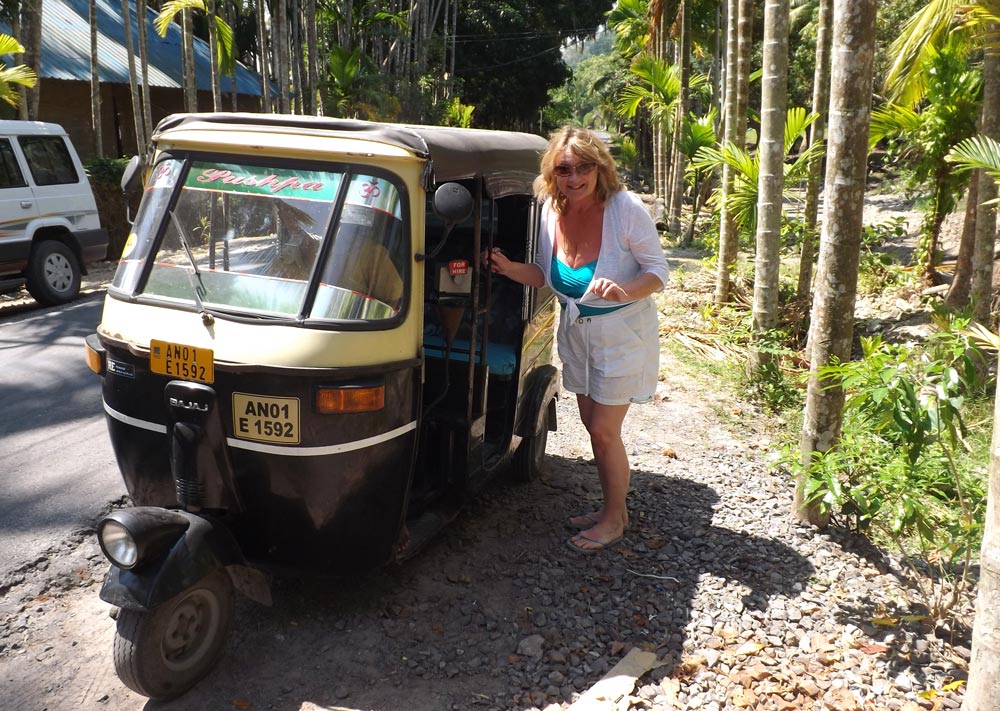 But first New Delhi; it is a developing city; new buildings and good roads but like most cities in the world, full of busy people all on a mission to get somewhere fast. Anyone who has ever watched the film, ‘The Most Exotic Marigold Hotel’ will have seen the driving capabilities of road users – they are MANIC. Cars, buses, tuc-tucs, tricycles, people carrying huge bundles on their heads, cows, dogs and monkeys and the rule is – well, actually – there are no apparent rules other than you must use your car/truck/bus horn to let people know you’re there, even when facing oncoming traffic! Otherwise, it’s every man, woman, child, animal for themselves. Within a few miles of leaving New Delhi behind, the early morning sun filtered weakly through acrid smog as we travelled through an industrial area; shades of Old England in the days of the industrial revolution. Then factories merged with the countryside and a succession of green fields, slum dwellings, chai shops and Indian people going about their morning ablutions in the fields alongside the roads, with none of the inhibitions of westerners.
But first New Delhi; it is a developing city; new buildings and good roads but like most cities in the world, full of busy people all on a mission to get somewhere fast. Anyone who has ever watched the film, ‘The Most Exotic Marigold Hotel’ will have seen the driving capabilities of road users – they are MANIC. Cars, buses, tuc-tucs, tricycles, people carrying huge bundles on their heads, cows, dogs and monkeys and the rule is – well, actually – there are no apparent rules other than you must use your car/truck/bus horn to let people know you’re there, even when facing oncoming traffic! Otherwise, it’s every man, woman, child, animal for themselves. Within a few miles of leaving New Delhi behind, the early morning sun filtered weakly through acrid smog as we travelled through an industrial area; shades of Old England in the days of the industrial revolution. Then factories merged with the countryside and a succession of green fields, slum dwellings, chai shops and Indian people going about their morning ablutions in the fields alongside the roads, with none of the inhibitions of westerners.
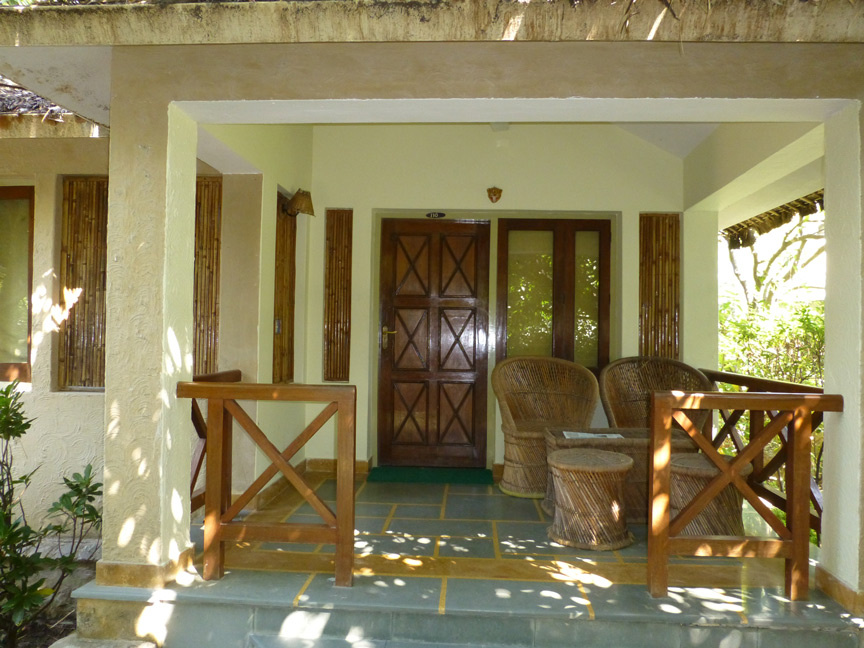 After a couple of temple stops for our driver en route, it was with great relief that we reached our first destination; Hotel Tiger Camp situated on the periphery of the Corbett Tiger Reserve in Ramnagar. We’d been travelling for around 24 hours. Sandy and I have fond memories of our last visit there but it was the first time for Lee who was still reeling from the sights, sounds and smells of India. The stopover gave us a chance to shower and chill before our onward journey at daybreak the next morning. We were returning to the temple at Bhikiyasein in the foothills of the Himalayas to fish for mahseer and goonch.
After a couple of temple stops for our driver en route, it was with great relief that we reached our first destination; Hotel Tiger Camp situated on the periphery of the Corbett Tiger Reserve in Ramnagar. We’d been travelling for around 24 hours. Sandy and I have fond memories of our last visit there but it was the first time for Lee who was still reeling from the sights, sounds and smells of India. The stopover gave us a chance to shower and chill before our onward journey at daybreak the next morning. We were returning to the temple at Bhikiyasein in the foothills of the Himalayas to fish for mahseer and goonch.
 Ramesh greeted us with a beaming smile; he was our second driver and when Sandy expressed trepidation at the journey ahead, he gave her his “very safe journey book” to read. Previous passengers had written many good comments about his driving and he was justifiably proud of it - every time she took a sharp intake of breath as we ascended into the foothills, he would repeat: “Very safe journey book. No problem”! He was amazing; always very smartly dressed, despite the heat, and patient enough to teach Sandy some Hindi (many times over!). True to his book, he IS a very safe driver; essential in that part of the world.
Ramesh greeted us with a beaming smile; he was our second driver and when Sandy expressed trepidation at the journey ahead, he gave her his “very safe journey book” to read. Previous passengers had written many good comments about his driving and he was justifiably proud of it - every time she took a sharp intake of breath as we ascended into the foothills, he would repeat: “Very safe journey book. No problem”! He was amazing; always very smartly dressed, despite the heat, and patient enough to teach Sandy some Hindi (many times over!). True to his book, he IS a very safe driver; essential in that part of the world.
 The road from Tiger Camp ascended gradually and at every bend, we expected to reach the top but the road ahead just kept rising. An occasional glimpse at the valleys below gave us spectacular views and a pretty good idea of the giddy heights we’d reached. We looked far down onto the layered terraces which must have taken generations to create, turning the hillside into smallholdings where families live miles far from major towns or cities. After a couple of hours, we reached a stopping point at just 8,000 ft. and to our delight were greeted by a sight which eluded us on our last adventure in India. In the near distance, we could see the snow-capped Himalayas glistening and pristine in the mid-morning sunlight - they were majestic. We stood, awestruck and silent. It’s probably an overused expression, but we couldn’t look away and valued every moment spent marvelling at their unspoilt beauty, a sharp contrast to the drive from New Delhi where, as in many areas of India, poor people live life on the edge.
The road from Tiger Camp ascended gradually and at every bend, we expected to reach the top but the road ahead just kept rising. An occasional glimpse at the valleys below gave us spectacular views and a pretty good idea of the giddy heights we’d reached. We looked far down onto the layered terraces which must have taken generations to create, turning the hillside into smallholdings where families live miles far from major towns or cities. After a couple of hours, we reached a stopping point at just 8,000 ft. and to our delight were greeted by a sight which eluded us on our last adventure in India. In the near distance, we could see the snow-capped Himalayas glistening and pristine in the mid-morning sunlight - they were majestic. We stood, awestruck and silent. It’s probably an overused expression, but we couldn’t look away and valued every moment spent marvelling at their unspoilt beauty, a sharp contrast to the drive from New Delhi where, as in many areas of India, poor people live life on the edge.
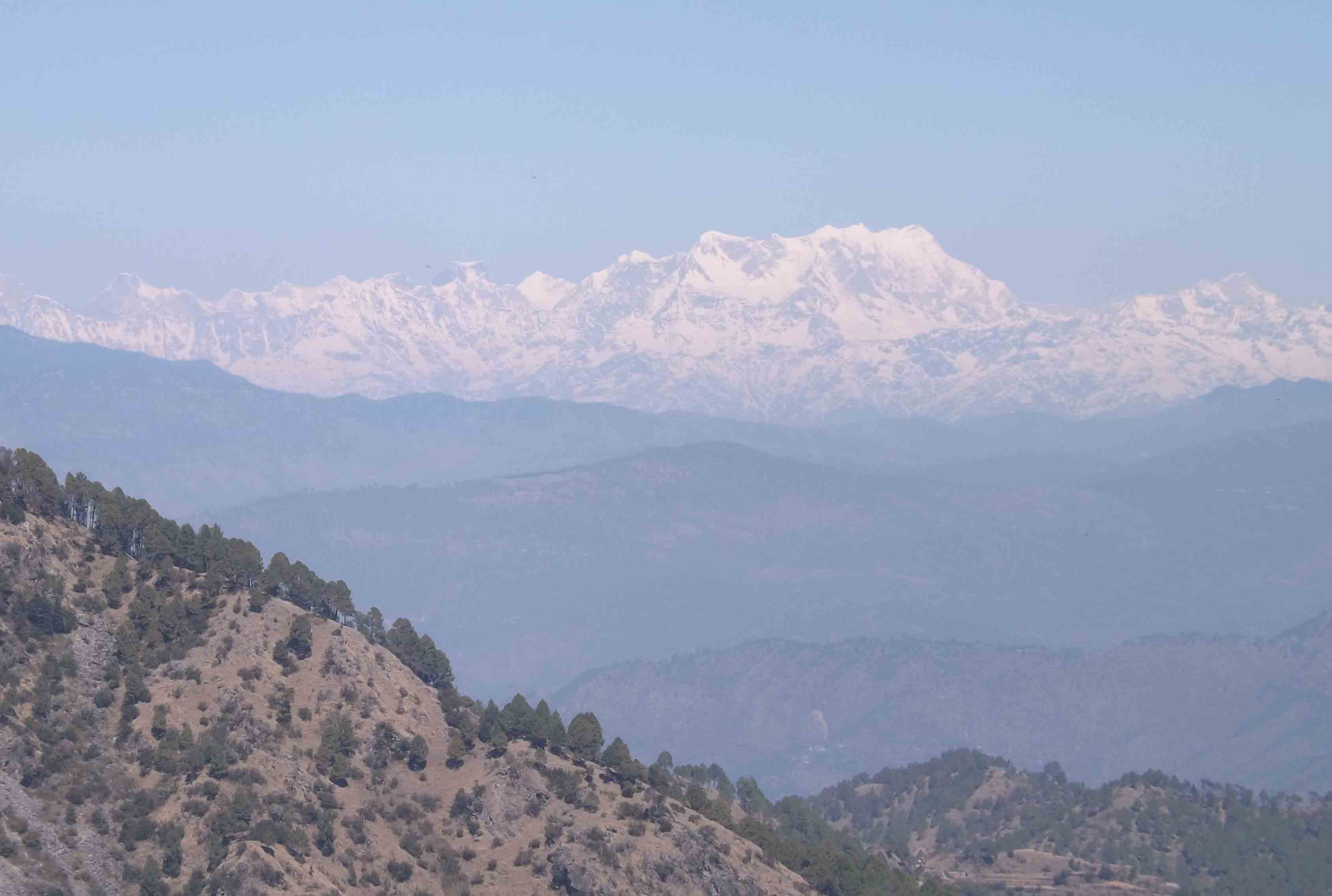 Our first sight of the Himalayas was one of those rare occasions which we will remember for the rest of our lives. Sadly and after only twenty minutes or so, Ramesh insisted we left, as people were waiting for us at the temple. We thought it would be our last sight of the mountain range which Lee now feels compelled to explore, but unknown to us, there was more to come on the return journey.
Our first sight of the Himalayas was one of those rare occasions which we will remember for the rest of our lives. Sadly and after only twenty minutes or so, Ramesh insisted we left, as people were waiting for us at the temple. We thought it would be our last sight of the mountain range which Lee now feels compelled to explore, but unknown to us, there was more to come on the return journey.
After a drive of an hour or so, and a brief stop in small rural town of Bhikiyasein to buy notebooks, we finally saw the ‘jewel’ of a temple in the valley below. It was exactly as we remembered, and the only disappointing aspect was that we only had a short time there as it was our base for five days whilst Lee and I fished for one of the most fantastic species of fish in the world; the mahseer, and also the prehistoric goonch.
Pretty much as we left them in 2011, Sherma and his brother Shiva were standing outside their tent which serves as home and kitchen during their stay at the temple. Accommodation for us was in the temple rooms which are simply furnished, having an ensuite (European loo) and a shower; great after our lengthy journey.
 The Hindu temple at Bhikiyasein is dedicated to one of the principal deities in Hindu faith, Lord Shiva and his consort, Parvati. It is situated on the Ramganga River and this is the haunt of mahseer, goonch and the small silver fish which the locals call chilwa (the equivalent of our small fry), plus the occasional mulli catfish.
The Hindu temple at Bhikiyasein is dedicated to one of the principal deities in Hindu faith, Lord Shiva and his consort, Parvati. It is situated on the Ramganga River and this is the haunt of mahseer, goonch and the small silver fish which the locals call chilwa (the equivalent of our small fry), plus the occasional mulli catfish.
Anyone who has watched Jeremy Wade’s ‘Jungle Hooks’ programme where he’s fishing for goonch and mahseer will recognise Corner Pool at the temple. It’s the same pool in which Jeremy swam underwater to find the lair of the goonch which rests in caves at the foot of the cliffs.
 But of course, Lee and I couldn’t wait to start fishing and we began by spinning in the Rock Pool. This is fed by two sources converging as the river splits a few hundred yards upstream, flowing between two large rock outcrops before running through rapids, into Corner Pool and then winding 90˚ right, creating a deeper area at the foot of a very high rock face. The river had changed since we visited in 2011 but Rock Pool looked enticing. We could actually see the mahseer in the crystal clear water; catching them was a different matter.
But of course, Lee and I couldn’t wait to start fishing and we began by spinning in the Rock Pool. This is fed by two sources converging as the river splits a few hundred yards upstream, flowing between two large rock outcrops before running through rapids, into Corner Pool and then winding 90˚ right, creating a deeper area at the foot of a very high rock face. The river had changed since we visited in 2011 but Rock Pool looked enticing. We could actually see the mahseer in the crystal clear water; catching them was a different matter.
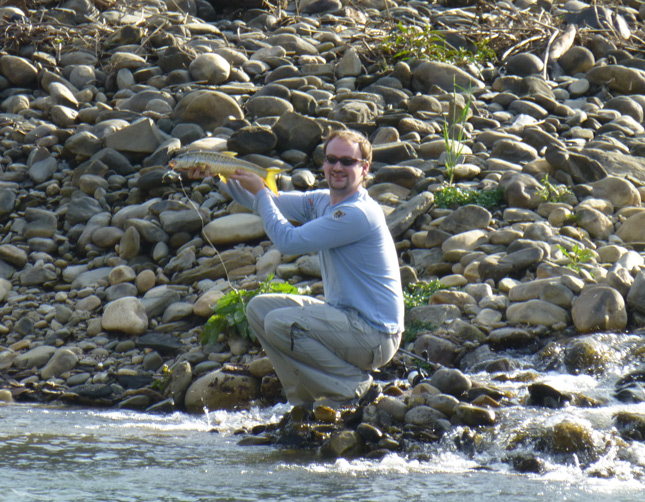 Our initial approach was to use Mepps 3 long without success. Lee then put on a small blue jointed Rapala and fished just where the one stream entered the pool and immediately caught a small mahseer of about 3lb. A good start, as these fish are very difficult to catch in such clear water where they can see everything and that fish proved to be the only one of the day so sensibly, we took advice from Ashmaram, our Indian guide who said the best approach would be to deadbait with blackfish. This is an algae-eating fish that the locals net, but due to the previous winter lasting longer the river was up and too powerful for the local netsman, so he made a simple loop net out of a spool of nylon line. This consisted of single row of loops laid in the river with a stone to anchor it at each end. The blackfish swim into it and get stuck, whereas the mahseer swim higher in the water and go over the net. It sounded good but the fish have to be of the right size to get caught, and though Ashmaram quickly caught one fish, it was a while before he caught another and we had to rely on the fine line tackle I had taken with a stick float to catch others.
Our initial approach was to use Mepps 3 long without success. Lee then put on a small blue jointed Rapala and fished just where the one stream entered the pool and immediately caught a small mahseer of about 3lb. A good start, as these fish are very difficult to catch in such clear water where they can see everything and that fish proved to be the only one of the day so sensibly, we took advice from Ashmaram, our Indian guide who said the best approach would be to deadbait with blackfish. This is an algae-eating fish that the locals net, but due to the previous winter lasting longer the river was up and too powerful for the local netsman, so he made a simple loop net out of a spool of nylon line. This consisted of single row of loops laid in the river with a stone to anchor it at each end. The blackfish swim into it and get stuck, whereas the mahseer swim higher in the water and go over the net. It sounded good but the fish have to be of the right size to get caught, and though Ashmaram quickly caught one fish, it was a while before he caught another and we had to rely on the fine line tackle I had taken with a stick float to catch others.
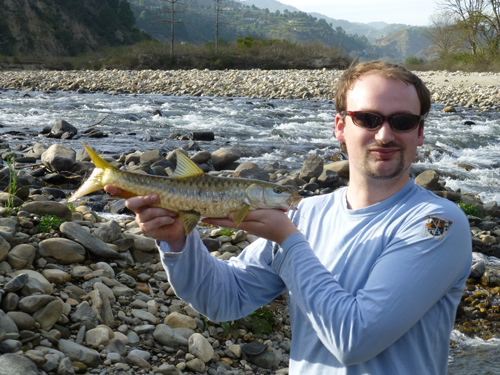 However, the most reliable source was a lad with a hand line. I gave him some size 16 hooks and he kept us supplied with small fish for bait. These were not as good as the blackfish, but did catch us bits and pieces.
However, the most reliable source was a lad with a hand line. I gave him some size 16 hooks and he kept us supplied with small fish for bait. These were not as good as the blackfish, but did catch us bits and pieces.
The next day we tried deadbaiting in Corner Pool. The weight used was a stone tied on with cotton, allowing it to break free when a fish took, and didn’t leave lead behind in the rocks as conventional legering would. Lee had a run and struck as the rod bent over, but the fish dropped the bait. We were told that this was because he had struck too soon, which is instinctive when you touch leger as much as we do. We had to let the mahseer pull against the reel, which they do without any problems, before winding and setting the hooks as we had with tarpon fishing. After that skirmish, the mahseer were skittish so we caught no further fish that day.
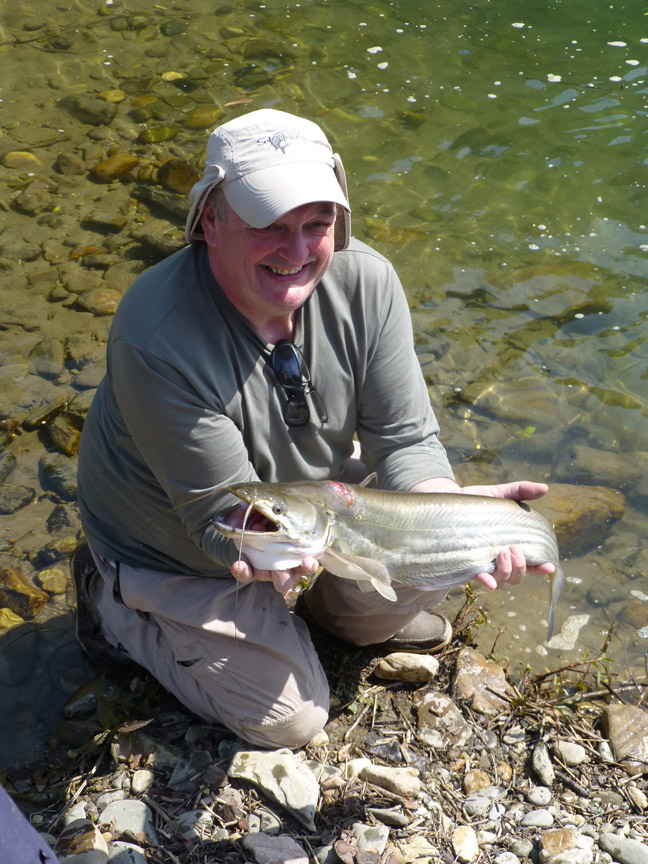 The next day, the same approach was used, and after only a few minutes I struck into a mulli. This is long-whiskered catfish which in the past used to be known as a freshwater shark. It’s in the same family group as goonch. This was returned and the pool left alone after the disturbance. Lee and I spent hours fish-watching and believed that Rock Pool would yield the best results, so as night approached, we deadbaited there. It was my turn to have a run which I struck as a reflex and the fish let go as before, this time taking the only blackfish with him.
The next day, the same approach was used, and after only a few minutes I struck into a mulli. This is long-whiskered catfish which in the past used to be known as a freshwater shark. It’s in the same family group as goonch. This was returned and the pool left alone after the disturbance. Lee and I spent hours fish-watching and believed that Rock Pool would yield the best results, so as night approached, we deadbaited there. It was my turn to have a run which I struck as a reflex and the fish let go as before, this time taking the only blackfish with him.
I should point out that night fishing in the wilds of India can be a little scary, and Lee and I huddled in a group of three with Ashmaram for an hour into the dark before packing up and returning to camp on the pretext that we were all hungry. A few evenings before our arrival, a leopard had taken a wild boar there and the killing had been reported enthusiastically to us by two Rumanian anglers who were there before us. We are fanatical fishermen, but we didn’t fancy a night encounter with a leopard down at the watering hole at Rock Pool.
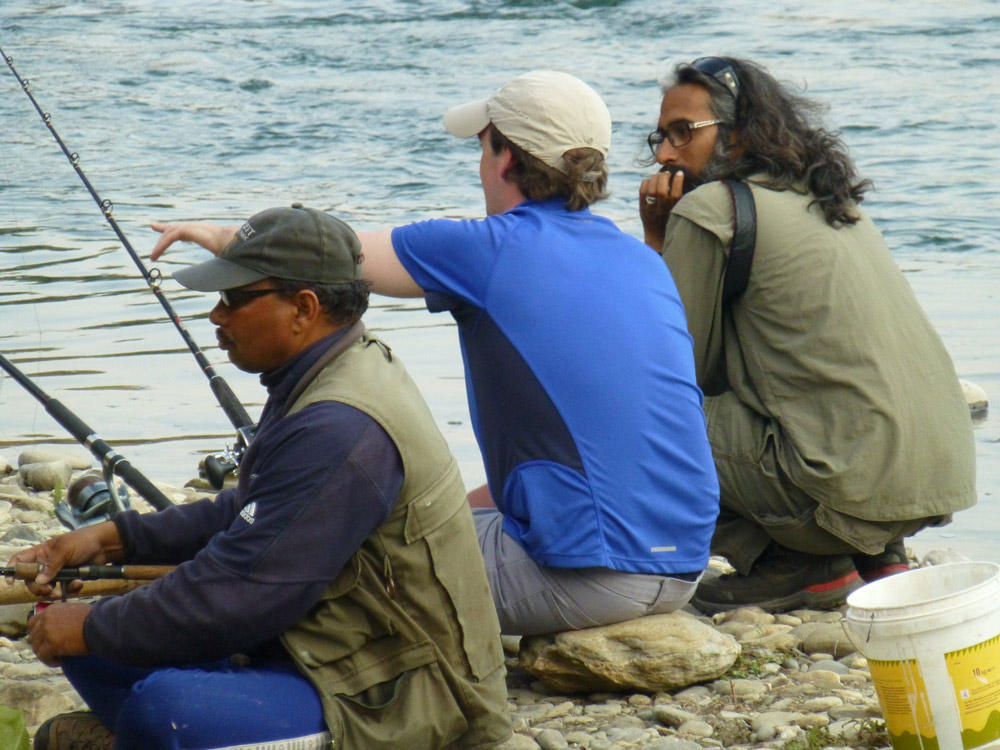 As ever, Sandy was there to chill and spent most of her time talking to Gaurav, our mercurial host, learning more about the country and Hindu religion. She felt privileged to be invited to evening prayers in the old temple and during the week, she was surprised that much of what she’d learnt and read in the UK was not factually correct. As her learning increased, so did her thirst for knowledge. Gaurav is charismatic and spent some of his spare time educating and enthusing her to the point where she was learning simple Hindi and since returning home, has been engrossed in Michael Wood’s book on India which is packed with history.
As ever, Sandy was there to chill and spent most of her time talking to Gaurav, our mercurial host, learning more about the country and Hindu religion. She felt privileged to be invited to evening prayers in the old temple and during the week, she was surprised that much of what she’d learnt and read in the UK was not factually correct. As her learning increased, so did her thirst for knowledge. Gaurav is charismatic and spent some of his spare time educating and enthusing her to the point where she was learning simple Hindi and since returning home, has been engrossed in Michael Wood’s book on India which is packed with history.
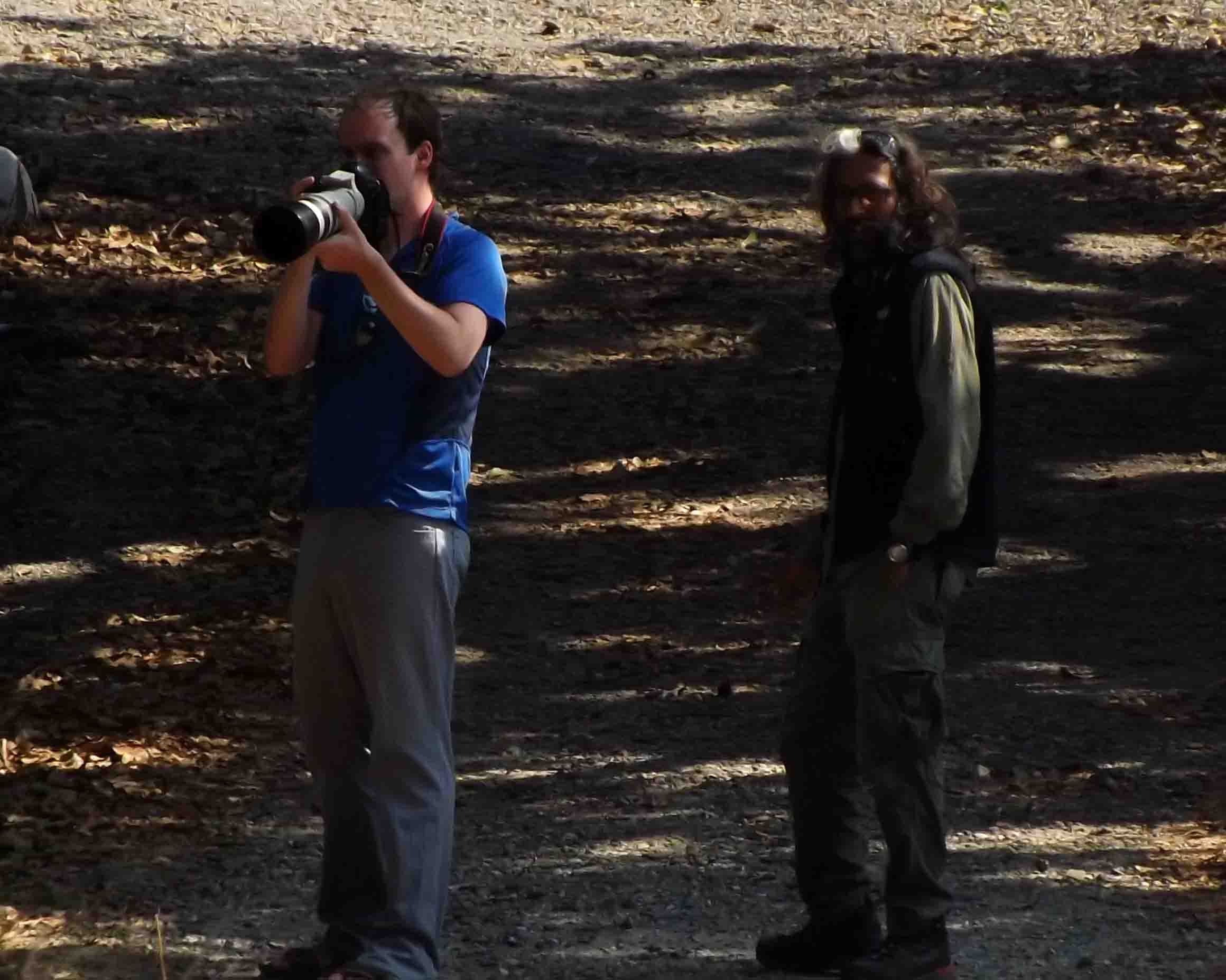 When Lee wasn’t fishing, he spent time bird-watching with me and Guarav who is a fanatical birder. He encouraged Lee to use one of his cameras with a long telephoto lens so he could take great shots of small and brightly coloured species. With over 700 photos of birds of India to his credit, he could spot things we couldn’t and we smiled to see Lee with his nose in a book of Birds of India; something new for him.
When Lee wasn’t fishing, he spent time bird-watching with me and Guarav who is a fanatical birder. He encouraged Lee to use one of his cameras with a long telephoto lens so he could take great shots of small and brightly coloured species. With over 700 photos of birds of India to his credit, he could spot things we couldn’t and we smiled to see Lee with his nose in a book of Birds of India; something new for him.
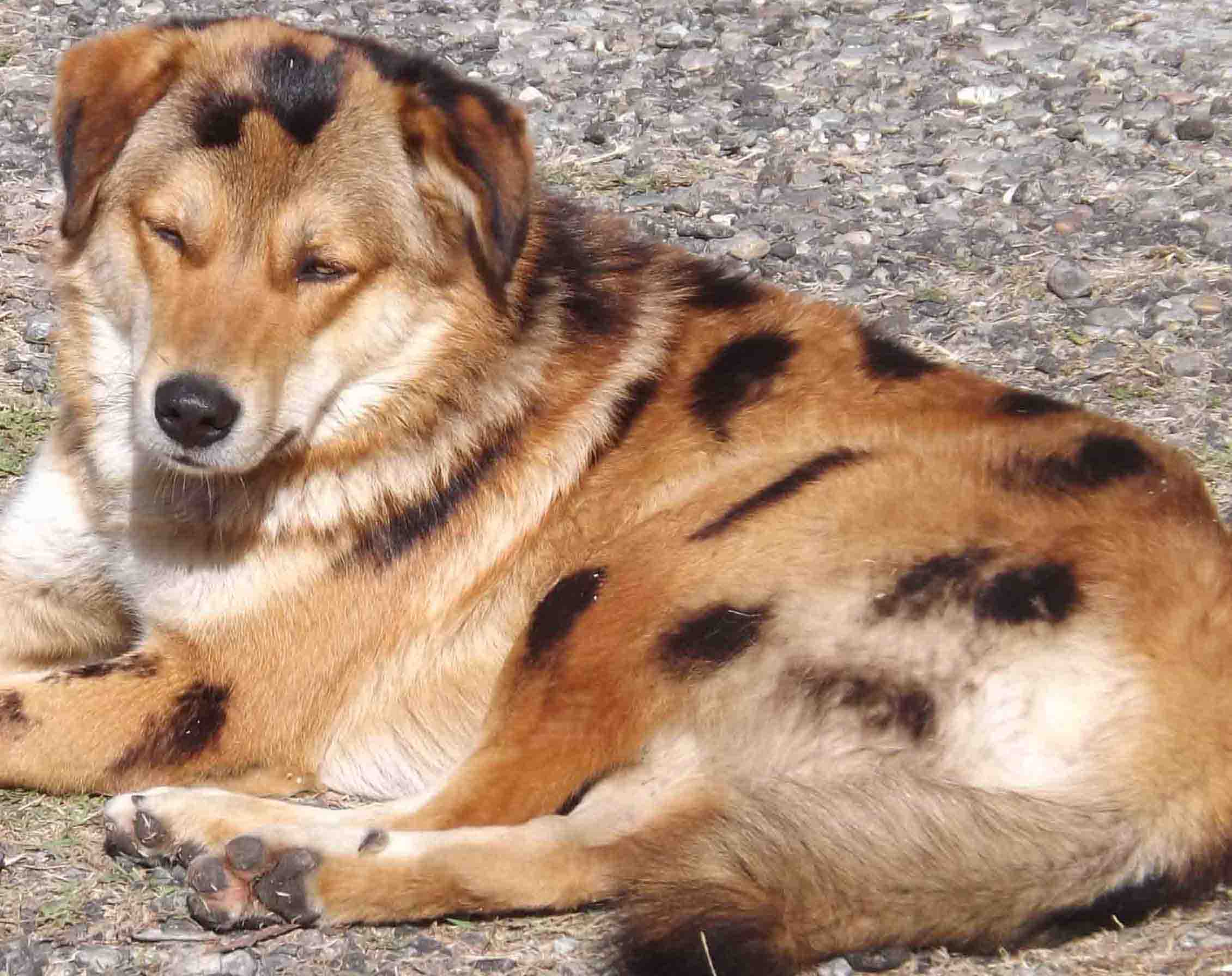 One of the most important members of the camp was an enigmatic canine who had been named: ‘Cheyrou’ by Sherma and Shiva. Much to our amusement, his owner who lived in a nearby village in the hills had dyed his coat to resemble a leopard. He’d abandoned his home for life at camp, for as long as there was food and companionship. On our last visit, three years ago, there were three dogs; one died of old age, one got run over and the third was eaten by a leopard whilst people were momentarily fetching water. Someone came up with the idea to use hair dye and paint leopard spots on the dog to cause confusion. It seemed to work while we were there as he was still very much alive when we left, and refused to stay home when the owner came to collect him. Much to our joy, he returned the next morning to join the fishing party.
One of the most important members of the camp was an enigmatic canine who had been named: ‘Cheyrou’ by Sherma and Shiva. Much to our amusement, his owner who lived in a nearby village in the hills had dyed his coat to resemble a leopard. He’d abandoned his home for life at camp, for as long as there was food and companionship. On our last visit, three years ago, there were three dogs; one died of old age, one got run over and the third was eaten by a leopard whilst people were momentarily fetching water. Someone came up with the idea to use hair dye and paint leopard spots on the dog to cause confusion. It seemed to work while we were there as he was still very much alive when we left, and refused to stay home when the owner came to collect him. Much to our joy, he returned the next morning to join the fishing party.
There is a steady rhythm to life at the temple and we seamlessly melted into the daily routine; temple music at sunrise to greet the day; wander across to the tent for a cup of masala chai, then breakfast overlooking Corner Pool, by which time the temperature was rising in the early morning sun. This was the best time for bird watching, and the river was still quiet until the sun warmed the river and the chilwa started to move. The mahseer weren’t active until around midday and this increased as the day progressed. It seemed that the best time to catch a big fish would probably be dusk or just afterwards. I don’t know if this level of activity continues into the night; we didn’t wait around to find out!
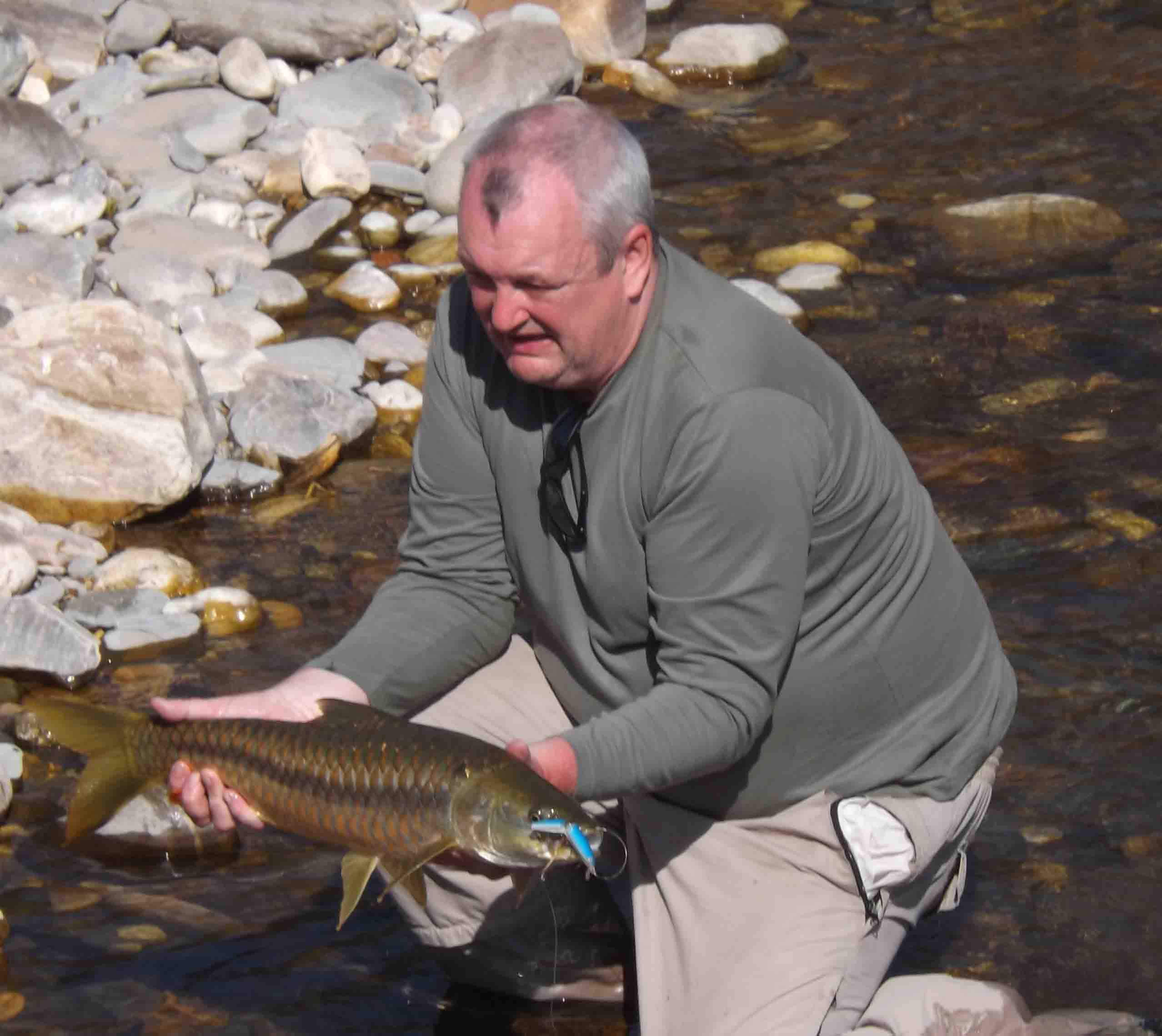 However, as I was chilwa fishing one lunchtime, I watched short bursts of activity as a mahseer “charged” the chilwa, and it this would set off the other fish which didn’t want to miss out. For around thirty seconds, the pool became alive. On one such occasion, I had my rod close at hand and the lure hadn’t moved three inches before it was hammered and I caught a 9lb fish. It seemed that if the fish weren’t in this receptive mood, they just wouldn’t take. I think the most likely answer is if they aren’t charging about, they can see the line, very much as chalk stream trout are very difficult to catch with imitation flies that don’t look like the ones hatching, especially on slow flows. We watched large fish swim up to baits and lures only to move sideways away from the line direction and swim straight past without even offering a take. The fish were there, we just couldn’t catch them!
However, as I was chilwa fishing one lunchtime, I watched short bursts of activity as a mahseer “charged” the chilwa, and it this would set off the other fish which didn’t want to miss out. For around thirty seconds, the pool became alive. On one such occasion, I had my rod close at hand and the lure hadn’t moved three inches before it was hammered and I caught a 9lb fish. It seemed that if the fish weren’t in this receptive mood, they just wouldn’t take. I think the most likely answer is if they aren’t charging about, they can see the line, very much as chalk stream trout are very difficult to catch with imitation flies that don’t look like the ones hatching, especially on slow flows. We watched large fish swim up to baits and lures only to move sideways away from the line direction and swim straight past without even offering a take. The fish were there, we just couldn’t catch them!
We did have two or three takes after dark, but these were missed, with the fish dropping the hooks. They had taken the bait but the rig, consisting of two or three single hooks dependant upon the size of the bait, came back minus the bait. Very frustrating! We wondered if a paternoster rig with a bait-runner would prove effective, but with limited time and tackle, we couldn’t experiment with this – next time!
Our week ended far too quickly, and with sadness, we waved goodbye to ‘Cheyrou’ and friends and left the temple where we’d enjoyed, peace, companionship and the tantalising sight of huge mahseer. Without doubt, we will return someday soon.
 Our return journey to the Corbett Reserve gave us another chance to see the snow-clad peaks of the Himalayas although a little misty this time, they were still a great thrill on our journey to Camp River Wild and two days on safari in the Corbett Tiger Reserve. Sandy and I have experienced the reserve before, and whilst we’ve never seen a tiger in the wild, we really wanted to visit again although a sign at the entrance to the park states: “You may not see the tiger, but the tiger sees you”. With heightened senses and keen anticipation, we entered the park in our open-topped jeeps shortly after daybreak. The morning mist was fading and we felt that something was watching us from the jungle. It’s necessary to have an approved driver and a government guide to accompany you but the guides didn’t want to get into our jeep as they know Guarav well; they know that a ride with him takes the maximum time allowed as he spends more time searching for wildlife and pointing out different birds for photographers, so the last one to get on a jeep drew the short straw. We were lucky to be with Gaurav and Sonu, the driver in the reserve, as they’re both knowledgeable birders and I was amazed at what they could see driving round, birds and animals which we very nearly missed. Sonu is also an expert tiger tracker. He would be driving, looking for birds and other wildlife and would suddenly stop, having spotted a tiger’s pug marks. We followed the tracks for a while and saw fresh pug marks, scent marks and scat, but sadly, never got to see the animal although we did hear a barking deer and its frantic alarm call. I believe that if tigers don’t want you to see them, you won’t, especially as you are not allowed out of the jeep, except at the observation tower. We saw vultures at one location but (very sensibly) were not allowed to investigate further; there had almost certainly been a tiger kill and it was probable that he or she was still feeding just over the brow of a hill within metres of our jeep. Sonu knew just where to look.
Our return journey to the Corbett Reserve gave us another chance to see the snow-clad peaks of the Himalayas although a little misty this time, they were still a great thrill on our journey to Camp River Wild and two days on safari in the Corbett Tiger Reserve. Sandy and I have experienced the reserve before, and whilst we’ve never seen a tiger in the wild, we really wanted to visit again although a sign at the entrance to the park states: “You may not see the tiger, but the tiger sees you”. With heightened senses and keen anticipation, we entered the park in our open-topped jeeps shortly after daybreak. The morning mist was fading and we felt that something was watching us from the jungle. It’s necessary to have an approved driver and a government guide to accompany you but the guides didn’t want to get into our jeep as they know Guarav well; they know that a ride with him takes the maximum time allowed as he spends more time searching for wildlife and pointing out different birds for photographers, so the last one to get on a jeep drew the short straw. We were lucky to be with Gaurav and Sonu, the driver in the reserve, as they’re both knowledgeable birders and I was amazed at what they could see driving round, birds and animals which we very nearly missed. Sonu is also an expert tiger tracker. He would be driving, looking for birds and other wildlife and would suddenly stop, having spotted a tiger’s pug marks. We followed the tracks for a while and saw fresh pug marks, scent marks and scat, but sadly, never got to see the animal although we did hear a barking deer and its frantic alarm call. I believe that if tigers don’t want you to see them, you won’t, especially as you are not allowed out of the jeep, except at the observation tower. We saw vultures at one location but (very sensibly) were not allowed to investigate further; there had almost certainly been a tiger kill and it was probable that he or she was still feeding just over the brow of a hill within metres of our jeep. Sonu knew just where to look.
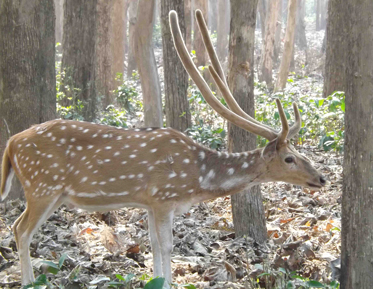
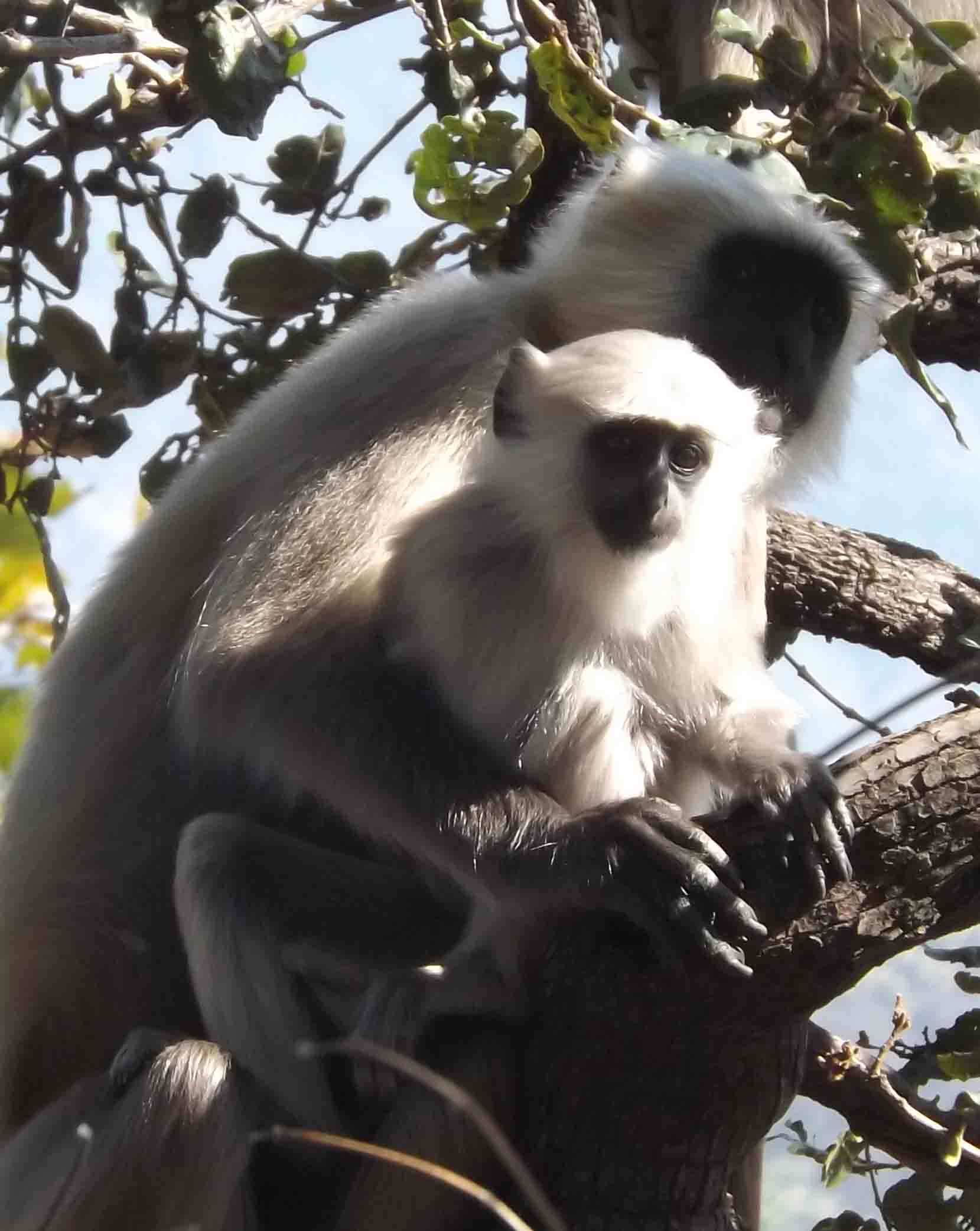 But, we did see wild elephants en route, samba, spotted and barking deer, and jackals hunting the latter. The trees were alive with langur monkeys, rhesus macaques, and superb birds, including a stork-billed kingfisher – Guarav has been searching for this bird for five years and was delighted to be able to photograph it feeding. He took a great shot of this bird with a fish headlong into its beak, which, as the name suggests looks as though it belongs on another bird. We loved every minute of the three trips into the reserve and didn’t mind not seeing a tiger – provided those who are fighting to save this magnificent animal and its habitat are successful, we will one day I’m sure.
But, we did see wild elephants en route, samba, spotted and barking deer, and jackals hunting the latter. The trees were alive with langur monkeys, rhesus macaques, and superb birds, including a stork-billed kingfisher – Guarav has been searching for this bird for five years and was delighted to be able to photograph it feeding. He took a great shot of this bird with a fish headlong into its beak, which, as the name suggests looks as though it belongs on another bird. We loved every minute of the three trips into the reserve and didn’t mind not seeing a tiger – provided those who are fighting to save this magnificent animal and its habitat are successful, we will one day I’m sure.
Next on the itinerary was fishing in the tiger reserve; however, the government had revoked our permit due to political problems. It is believed that two ex-government ministers had got approval for building resorts within the reserve, and had guests driving around and fishing outside the permitted hours. The local tribals, whose land it is, objected and requested permission to build their own resort which was refused. In the fallout, the Government banned all fishing within the reserve and effectively closed the resorts but like everything else in India, this is of course subject to change.
 This latest change of plan (our trip was beset with them) meant that we had to travel further afield, to a more extreme spot. Lee and I were driven into the hills where Guarav pointed down the valley and said ‘There’s the river!’ It was 1800 feet below, and the only access was down a narrow track, some of which was treacherous scree. Idiots that we are, we said ‘alright’ and off we went taking nearly an hour to get down to the river, which we were told (and I don’t doubt) was an excellent goonch spot.
This latest change of plan (our trip was beset with them) meant that we had to travel further afield, to a more extreme spot. Lee and I were driven into the hills where Guarav pointed down the valley and said ‘There’s the river!’ It was 1800 feet below, and the only access was down a narrow track, some of which was treacherous scree. Idiots that we are, we said ‘alright’ and off we went taking nearly an hour to get down to the river, which we were told (and I don’t doubt) was an excellent goonch spot.
Sherma was first down to find a family of over a dozen otters playing in the pool, and a leopard skulking around in the undergrowth, all of which had disappeared when the rest of us got there minutes later.
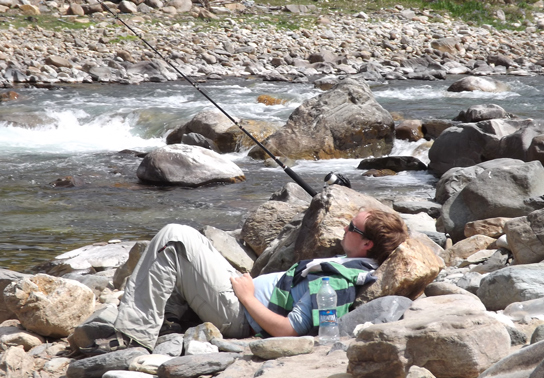 Before long, Lee had a run which started dragging his rod towards the river. He wound-down, set the hooks and ... nothing! The bait came back. That spooked everything for the day as the pools we fished there are small and deep, ideal goonch habitat.
Before long, Lee had a run which started dragging his rod towards the river. He wound-down, set the hooks and ... nothing! The bait came back. That spooked everything for the day as the pools we fished there are small and deep, ideal goonch habitat.
 After a great day fishing the wild river, we packed away our gear and looked up at the narrow path, wondering how the hell we were going to get back to our waiting jeeps. Gaurav, ever resourceful, had the answer. He’d made contact with a local who has mules and they were sent down the steep descent to collect us. Sherma and Shiva took the tackle and walked up the slope like it was a Sunday stroll. They are Nepalese where they breed a race of supermen, some of whom are employed as Sherpas by climbers on Everest. They are unbelievably strong and fit and we felt feeble and decrepit alongside them. Gaurav hadn’t asked for a horse for Ramesh, our driver, who tried to walk up with the others whilst Gaurav, Ashmaram, Lee and I took the mules. My poor animal started shaking when he saw me. Gaurav convinced his owner that I weigh less than 90kgs (only 20 out) and so he let me ride his mule, which sure-footedly made it to the top on a path about 12” wide without collapsing. It was frightening; you just have to have faith in the animal … and hope, because one foot out of place would have sent man and mule to certain death in the valley below. One member of our party refused to take the ride up and every so often, would ask: “Are we nearly there yet?” He didn’t make the descent again!
After a great day fishing the wild river, we packed away our gear and looked up at the narrow path, wondering how the hell we were going to get back to our waiting jeeps. Gaurav, ever resourceful, had the answer. He’d made contact with a local who has mules and they were sent down the steep descent to collect us. Sherma and Shiva took the tackle and walked up the slope like it was a Sunday stroll. They are Nepalese where they breed a race of supermen, some of whom are employed as Sherpas by climbers on Everest. They are unbelievably strong and fit and we felt feeble and decrepit alongside them. Gaurav hadn’t asked for a horse for Ramesh, our driver, who tried to walk up with the others whilst Gaurav, Ashmaram, Lee and I took the mules. My poor animal started shaking when he saw me. Gaurav convinced his owner that I weigh less than 90kgs (only 20 out) and so he let me ride his mule, which sure-footedly made it to the top on a path about 12” wide without collapsing. It was frightening; you just have to have faith in the animal … and hope, because one foot out of place would have sent man and mule to certain death in the valley below. One member of our party refused to take the ride up and every so often, would ask: “Are we nearly there yet?” He didn’t make the descent again!
When we eventually reached the top of the hill, poor Ramesh was absolutely exhausted and dishevelled and even though I can’t speak Hindi, I could understand what he was saying to Gaurav; it wasn’t polite! He’d encouraged him to slide down the slope and had told him there would be a horse to take him back up, which he then gave to Lee. We were all falling about laughing which only made him worse. Then he noticed he had a flat tyre and it was his job to change it; not an easy task in the wilds of India when the spare is also flat. It was the only occasion on which the smile disappeared from his face in the entire time we spent with him.
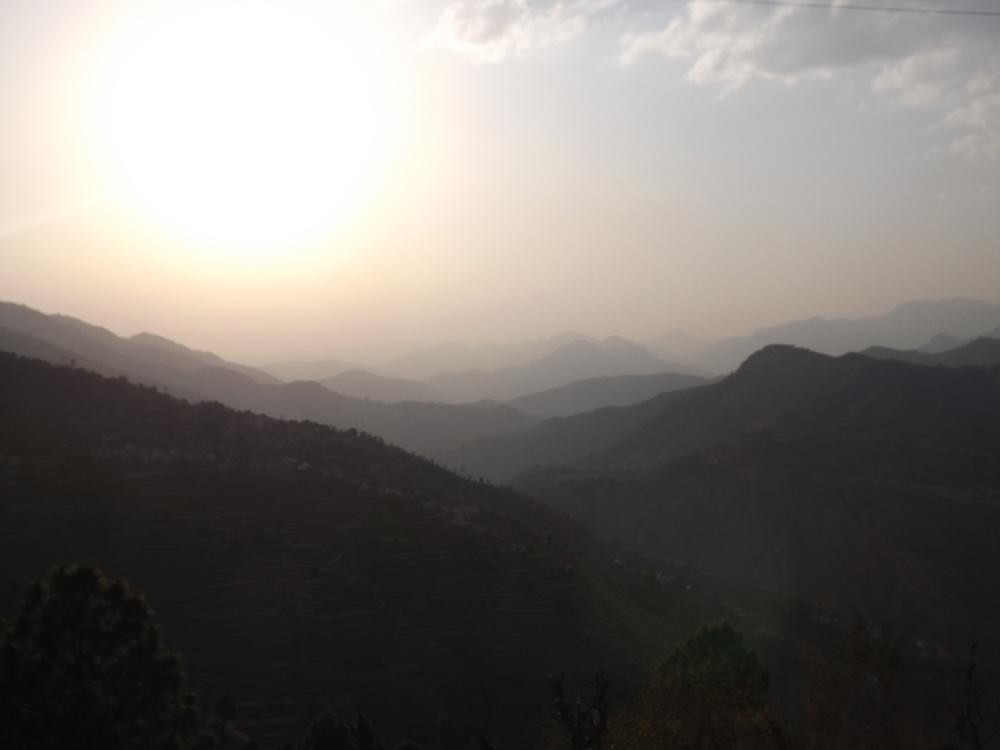 This last adventure brought Lee’s part of the journey to a close and all that remained for him was the night train from Ramnagar to Old Delhi and an overnight stay before his flight home. We’d had a fabulous time and it was with great sadness that we had to say goodbye him. India is many things; it was an eye-opener for Lee but never a disappointment. People are so friendly, and the jokes and mickey-taking in our group made for a vacation we will not forget. The fishing wasn’t over prolific but the scenery was spectacular; it’s always part of a learning curve and when we return, our tactics will be different, as will the river which is ever-changing. We learn more each time we visit, both of the culture and the fishing and can’t wait to be there again. Given the money, we would be off there tomorrow.
This last adventure brought Lee’s part of the journey to a close and all that remained for him was the night train from Ramnagar to Old Delhi and an overnight stay before his flight home. We’d had a fabulous time and it was with great sadness that we had to say goodbye him. India is many things; it was an eye-opener for Lee but never a disappointment. People are so friendly, and the jokes and mickey-taking in our group made for a vacation we will not forget. The fishing wasn’t over prolific but the scenery was spectacular; it’s always part of a learning curve and when we return, our tactics will be different, as will the river which is ever-changing. We learn more each time we visit, both of the culture and the fishing and can’t wait to be there again. Given the money, we would be off there tomorrow.
On arriving back in Old Delhi, we left Lee at his Hotel, whilst Sandy and I switched to New Delhi station and travelled due north. Having just raved about India, one of the worst experiences we’ve had so far is arriving in old Delhi station. Even at 4.30 am there were masses of people everywhere. One young boy tried to steal from Sandy’s handbag as she joined the throng to walk up the steps out of the station. Fortunately she noticed, as did Lee who was following close behind. Our passports and tickets were in the bag; if there’s a next time, Sandy says she’ll put a sandwich, drink and a 100 rupee note in there and let them take it. It’s the way of life for many young people and is very hard to bear. They sleep on the floor amidst the dirt and chaos of human traffic, and the smell is almost indescribable, human excrement in heat and dust is overwhelming. We got out of there as quickly as possible, and were met by another driver who was waiting to take us to New Delhi station where we caught a train to Chandagarh which is in sharp contrast to Old Delhi. New Delhi is where the “great and the good” live and is the complete opposite of Old Delhi and its slums. Tree lined pavements with modern roads, big houses, expensive hotels and a modern, well-ordered station.
 Even the train was newer with comfortable seats, air conditioning and refreshments en route. It was morning and the journey was so smooth and comfortable that I instantly went to sleep. However, Sandy was awake and saw sights, which in India, don’t seem to faze people. Within a few metres of leaving the station, she saw a dog’s corpse which had been cut in half by a train and a few metres further on, the back end of a young cow, the front end of which was being eaten by three stray dogs; but as the train continued on its journey, she saw a succession of green fields, slums, people going about their business and life in the raw. This journey took around five hours and arrival Chandagarh was another surprise with its wide tree-lined roads and modern buildings. There we were met by another driver who was very pleasant, but didn’t speak English. He drove us safely up into the hills, a journey of around four hours – our destination - Shimla, the old British headquarters where the well-to-do would spend their summers when it got too hot for comfort in the plains.
Even the train was newer with comfortable seats, air conditioning and refreshments en route. It was morning and the journey was so smooth and comfortable that I instantly went to sleep. However, Sandy was awake and saw sights, which in India, don’t seem to faze people. Within a few metres of leaving the station, she saw a dog’s corpse which had been cut in half by a train and a few metres further on, the back end of a young cow, the front end of which was being eaten by three stray dogs; but as the train continued on its journey, she saw a succession of green fields, slums, people going about their business and life in the raw. This journey took around five hours and arrival Chandagarh was another surprise with its wide tree-lined roads and modern buildings. There we were met by another driver who was very pleasant, but didn’t speak English. He drove us safely up into the hills, a journey of around four hours – our destination - Shimla, the old British headquarters where the well-to-do would spend their summers when it got too hot for comfort in the plains.
Having seen it on the hill railway programmes on BBC television, it looked beautiful. It wasn’t and we arrived at the wrong time of year – their winter – which is why I think Guarav was laughing as we left him. It absolutely poured with rain which turned to snow on the hills, and the mother of all thunder storms woke us in the night. The temperature was around 0˚ - quite a shock after the heat in the foothills which had been around 30˚ - Sandy says that will teach her to do her homework before the next trip – we should have known what to expect.
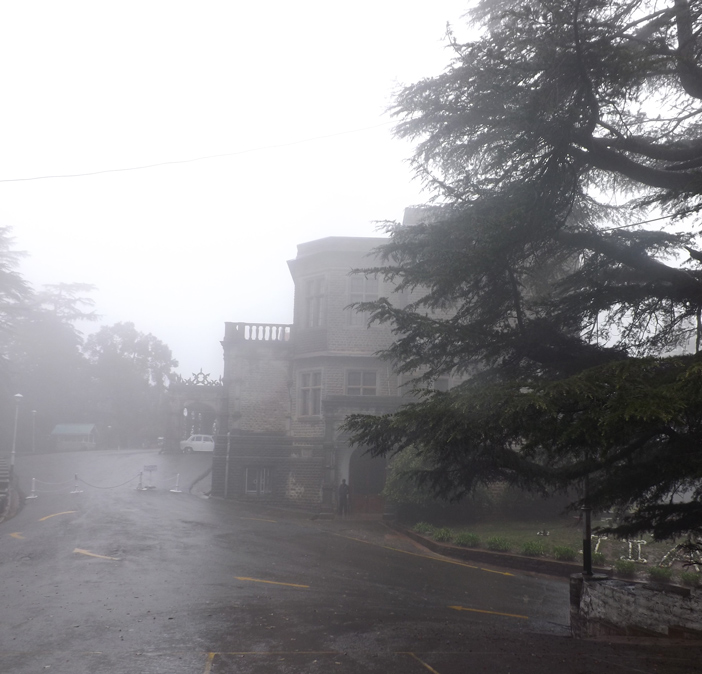 We’d planned to spend a day sight-seeing which had been arranged for us, but here we had a few hiccups. The driver didn’t speak any English except “yes” which he used in answer to every question. We had a brief conversation with the hotel manager who informed us that we would be going to the “bicycle museum” in the morning, then we would take the lift to the next level (which we missed) and then to the hill valley railway for 2.00 p.m. to catch the train. This sounded great and we were up early the next morning (after the thunderstorm) and raring to go but it was raining hard!!! Our driver arrived (he was from Delhi and had no experience of Shimla) and we told him with the help of the receptionist that we were going to the museum (we were still wondering about a bicycle museum in the Himalayas). He seemed to know the way but got lost and eventually found a museum which we toured. No sign of any bicycles! As we walked around, there were old photos of Shimla where I saw the ‘Viceregal’ and the penny dropped. We weren’t meant to be at that museum but the Viceregal’s (definitely sounds like ‘bicycle’ in rapid Hindi) Lodge which is now a learning institute for post-grad studies, so running late, we quickly scooted to the Lodge for the next part of excursion. Built with great foresight 1886, it has an inbuilt electrics and fire sprinkler system based on wax plugs in the tubing filled with nitrogen, so any heat pressurises the pipe and melts the wax forcing the gas out, followed by water to quench any fire - very novel, but maybe not so well thought out in a wood-panelled building, which houses an extensive library. They even have tanks for this purpose in which rainwater is stored. It is a shame modern buildings aren’t built to this standard but on the downside, I think they are the original electrics! This building is of significant historic interest; amongst other things, the document for the partition of India was signed by ‘the great and the good’ there in 1947. This visit, although short took us way past our departure time of 2.00 p.m. so we missed our train ride, which was Sandy’s part of the trip and her main reason for making the lengthy detour.
We’d planned to spend a day sight-seeing which had been arranged for us, but here we had a few hiccups. The driver didn’t speak any English except “yes” which he used in answer to every question. We had a brief conversation with the hotel manager who informed us that we would be going to the “bicycle museum” in the morning, then we would take the lift to the next level (which we missed) and then to the hill valley railway for 2.00 p.m. to catch the train. This sounded great and we were up early the next morning (after the thunderstorm) and raring to go but it was raining hard!!! Our driver arrived (he was from Delhi and had no experience of Shimla) and we told him with the help of the receptionist that we were going to the museum (we were still wondering about a bicycle museum in the Himalayas). He seemed to know the way but got lost and eventually found a museum which we toured. No sign of any bicycles! As we walked around, there were old photos of Shimla where I saw the ‘Viceregal’ and the penny dropped. We weren’t meant to be at that museum but the Viceregal’s (definitely sounds like ‘bicycle’ in rapid Hindi) Lodge which is now a learning institute for post-grad studies, so running late, we quickly scooted to the Lodge for the next part of excursion. Built with great foresight 1886, it has an inbuilt electrics and fire sprinkler system based on wax plugs in the tubing filled with nitrogen, so any heat pressurises the pipe and melts the wax forcing the gas out, followed by water to quench any fire - very novel, but maybe not so well thought out in a wood-panelled building, which houses an extensive library. They even have tanks for this purpose in which rainwater is stored. It is a shame modern buildings aren’t built to this standard but on the downside, I think they are the original electrics! This building is of significant historic interest; amongst other things, the document for the partition of India was signed by ‘the great and the good’ there in 1947. This visit, although short took us way past our departure time of 2.00 p.m. so we missed our train ride, which was Sandy’s part of the trip and her main reason for making the lengthy detour.
 Given the poor visibility and penetrating cold, we reluctantly accepted that we were not going to fulfil this part of our journey and shivering, we headed back to our room where, outside on the balcony, the macaques were busy throwing the furniture (and each other) around on the balcony. Boy they’re aggressive!!
Given the poor visibility and penetrating cold, we reluctantly accepted that we were not going to fulfil this part of our journey and shivering, we headed back to our room where, outside on the balcony, the macaques were busy throwing the furniture (and each other) around on the balcony. Boy they’re aggressive!!
We were very glad to leave Shimla (never to return) the next morning and head to Kalka to catch the train back to New Delhi. Sandy viewed the train in tired despair until I spotted a list of passengers’ names Sellotaped to the carriage – Mrs. Sandra and Mr. Keith – another sleeper train. Sandy was exhausted from a sleepless night and we had been allocated the top tier of bunks (three high) which only the young and very agile would tackle. She was dismayed but a very kind gentlemen from Mumbai saw how tired she was and offered her his lower bunk on which she slept, whilst he and I sat and talked. A family comprising, grandmother, mother and son joined our compartment at Chandagarh and with typical hospitality, offered me their food. They were on a 30-hour train journey to Mumbai. As ever, the people were very kind and a pleasure to be with. In the UK, we could learn much from Indian people who, in the main, have far less to give but often share it willingly. My male companion expressed concern about our arrival in New Delhi station; he explained that local cabbies can exploit unwary tourists. We said that a driver was collecting us and that a Delhi-based travel company (A E Travel) had organised it – he was happy with that. He said that was so much better than trying to organise travel from the UK where tour operators don’t know who they are dealing with – (a tip to bear in mind when travelling in India).
On arrival in New Delhi, Sandy and I were collected by yet another driver. She hadn’t eaten her lunch but didn’t want to throw it away as there are many hungry people there and she intended to leave it alongside one of the homeless people who sleep in the station. She told our driver who took it and gave it to a young woman with a child. We were very impressed with him; he has a social conscience and seemed mildly dispirited about the corruption in India, and then reasoned that it is probably the same the world over.
Next, we arrived in Indira Gandhi airport (very impressive) for a flight to Chennai where we would spend a night before our flight to Port Blair in the Andamans. As before, everything went smoothly until our arrival in Chennai at around 11.00 p.m. Hit by exhaustion and a wave of intense humidity, we searched amongst a sea of faces for our next driver, but he was nowhere to be found. For some strange reason, he hadn’t thought it necessary to display our names so that we could locate him; with no ‘phone and only Guarav’s number, Sandy found a very helpful railway employee (they have them in India) who saw us searching and rang Guarav who was back in the foothills of the Himalayas – within minutes, our driver appeared and thankfully, we made it to the hotel by midnight, joining our friend Reg Talbot who was accompanying us on the last part of the trip. We managed a short sleep before travelling onwards the next morning.
Impatient to reach our final destination, we were up early to catch the plane to Port Blair in the Andaman Islands. Guarav had previously told us that the Government had cancelled all the ferries on the day that we should have been travelling, so A E Travel had booked us into a nice hotel and onto the first ferry the following morning. If we had had to arrange this with a UK agent, it would have been a nightmare – as it was, it was a pleasurable hiccup.
 Sandy was very happy at our next hotel; it had a pool; the temperature was 33˚ and it was steamy, so without delay, she changed into a swimsuit and headed for a swim. I grabbed my camera and walked with her before going down to the shore to photograph birds and look for fish. As Sandy walked over the grass towards the pool, I glanced down and saw a large snake, about 5 feet long slither across the grass at high speed away from her; without her glasses, she didn’t even notice and was very annoyed because she missed it – it was a whopper! She loved the pool as it was the first swim she’d had since arriving in India. Reg joined me in watching small fish amongst the rocks and we spent the rest of the day chilling out in the terrace bar. It was very hot and humid there, so much so that the bed sheets felt wet and it was impossible to dry wet hair, but it was nowhere near as humid as in Chennai where IPL cricket is being played right now. We can still feel the heat!
Sandy was very happy at our next hotel; it had a pool; the temperature was 33˚ and it was steamy, so without delay, she changed into a swimsuit and headed for a swim. I grabbed my camera and walked with her before going down to the shore to photograph birds and look for fish. As Sandy walked over the grass towards the pool, I glanced down and saw a large snake, about 5 feet long slither across the grass at high speed away from her; without her glasses, she didn’t even notice and was very annoyed because she missed it – it was a whopper! She loved the pool as it was the first swim she’d had since arriving in India. Reg joined me in watching small fish amongst the rocks and we spent the rest of the day chilling out in the terrace bar. It was very hot and humid there, so much so that the bed sheets felt wet and it was impossible to dry wet hair, but it was nowhere near as humid as in Chennai where IPL cricket is being played right now. We can still feel the heat!
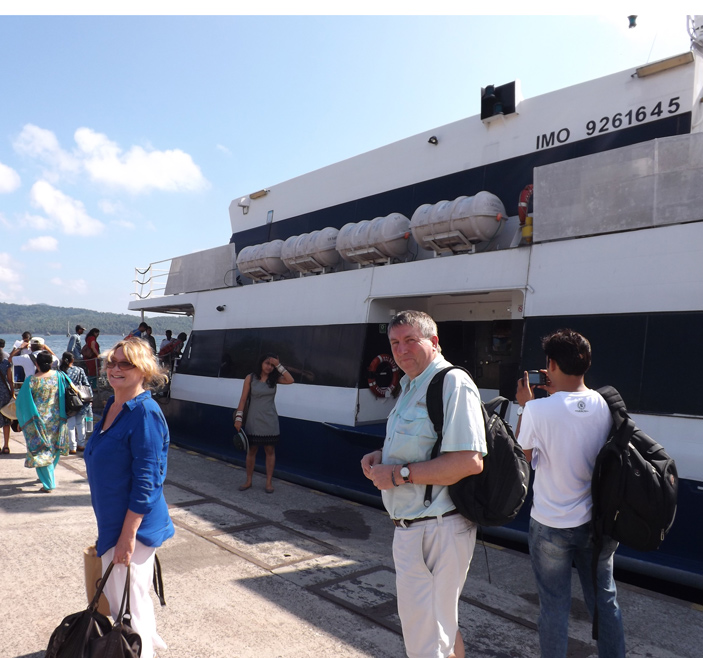
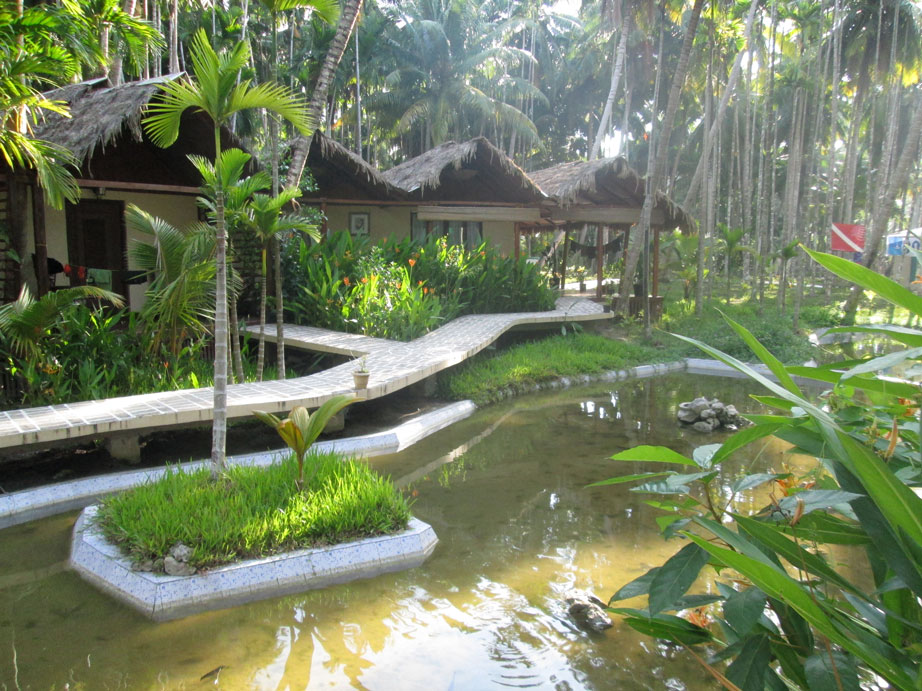 Next morning, we were up bright and early and on the ferry by 8.00 am. It was a modern catamaran built in Singapore and we had a luxuriously smooth ride to Havelock Island which was our base for the next week at Munjoh’s beachfront resort. No sooner had the ferry docked than our local guide Qutub was there to meet us, telling us that our fishing boat was ready if we wanted to go straight off – we did but we needed to get rid of our bags (and Sandy) first so opted to check in and have some lunch before going out fishing in the afternoon.
Next morning, we were up bright and early and on the ferry by 8.00 am. It was a modern catamaran built in Singapore and we had a luxuriously smooth ride to Havelock Island which was our base for the next week at Munjoh’s beachfront resort. No sooner had the ferry docked than our local guide Qutub was there to meet us, telling us that our fishing boat was ready if we wanted to go straight off – we did but we needed to get rid of our bags (and Sandy) first so opted to check in and have some lunch before going out fishing in the afternoon.
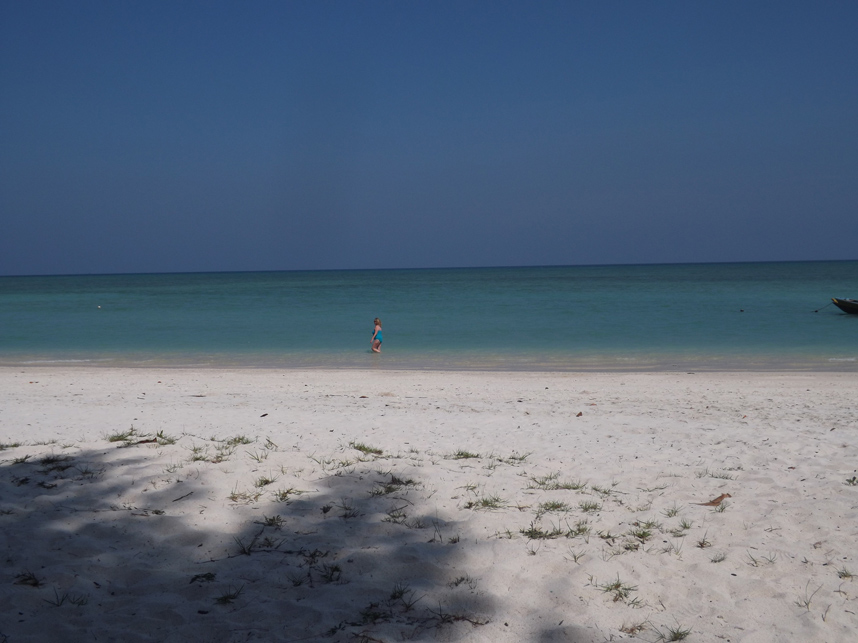 Havelock Island is very similar to a Caribbean island with white sands, shallow beaches, palm trees, and apart from a settlement at one end, virtually uninhabited. I have pictures of Sandy on the beach with no-one else in sight. After checking in, Reg and I were straight out fishing on a boat which looked impressive, but once aboard, we could learned that it was a converted Doongi; a local wooden boat which had been extended up the side and a rail fitted. The boat was painted white to resemble fibreglass and the rail was bamboo painted silver, but it had a toilet, a kitchen and, more importantly, an icebox for drinks and a Yamaha outboard for trolling, so what more could we want. It was a quirky Indian boat but this merely added to the fun of the experience.
Havelock Island is very similar to a Caribbean island with white sands, shallow beaches, palm trees, and apart from a settlement at one end, virtually uninhabited. I have pictures of Sandy on the beach with no-one else in sight. After checking in, Reg and I were straight out fishing on a boat which looked impressive, but once aboard, we could learned that it was a converted Doongi; a local wooden boat which had been extended up the side and a rail fitted. The boat was painted white to resemble fibreglass and the rail was bamboo painted silver, but it had a toilet, a kitchen and, more importantly, an icebox for drinks and a Yamaha outboard for trolling, so what more could we want. It was a quirky Indian boat but this merely added to the fun of the experience.
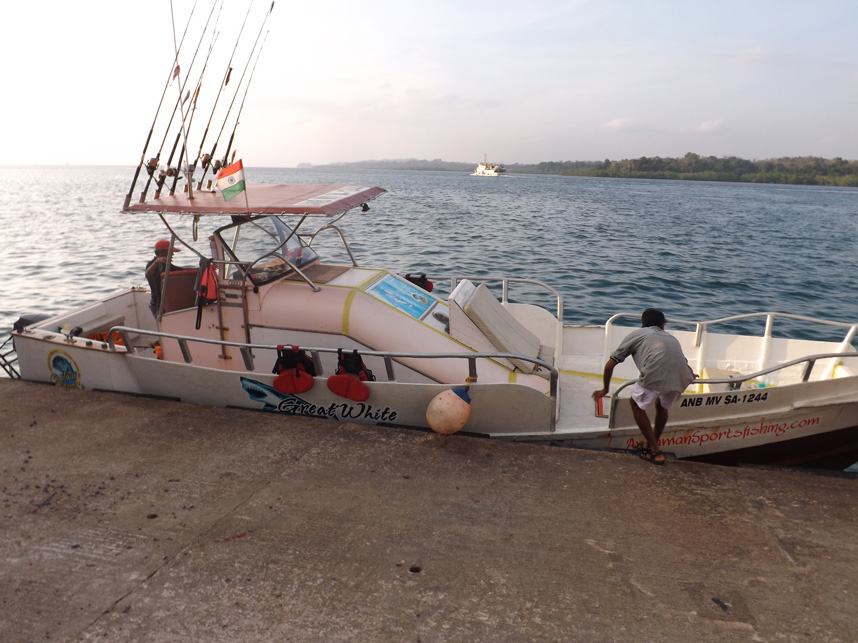 Reg and I tossed a key (not having a coin) to see who would take the first fish alternating thereafter and I won). In the afternoon, we couldn’t go far so fished local reefs. The approach used is to troll between the reef picking up bonus fish, but when you get to the reefs you look for fish balls and the use popper (plugs on the surface which pop when jerked rapidly) of stick lures which wobble subsurface when fished at high speed. This sounds easy but it is incredibly hard work as the rates of retrieve are very high and the lures are huge.
Reg and I tossed a key (not having a coin) to see who would take the first fish alternating thereafter and I won). In the afternoon, we couldn’t go far so fished local reefs. The approach used is to troll between the reef picking up bonus fish, but when you get to the reefs you look for fish balls and the use popper (plugs on the surface which pop when jerked rapidly) of stick lures which wobble subsurface when fished at high speed. This sounds easy but it is incredibly hard work as the rates of retrieve are very high and the lures are huge.
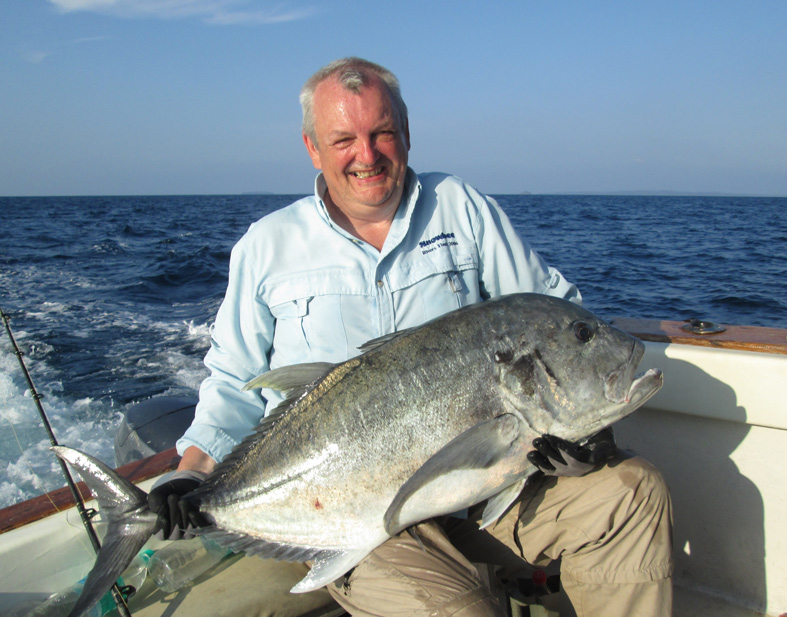 On the first day out, the catch was a giant trevally (my first ever and another species on my list of nearly 100) of around 22kg (47lb). The next day Reg caught the first fish trolling of around the same size before we started lure fishing. I had a couple of shows from good fish but no takes. Reg had a sailfish flash at his lure as he lifted it from the water.
On the first day out, the catch was a giant trevally (my first ever and another species on my list of nearly 100) of around 22kg (47lb). The next day Reg caught the first fish trolling of around the same size before we started lure fishing. I had a couple of shows from good fish but no takes. Reg had a sailfish flash at his lure as he lifted it from the water.
 As we became exhausted we decided to bait fish over a reef. This was incredible; there were so many fish that any bait was stripped in about 30 seconds, often without sensing anything on the line. After an hour or so Reg and I had caught three or four fish each, yet to be identified but are probably grouper or trigger fish of some type. More popping and Reg caught a barracuda in the tail!
As we became exhausted we decided to bait fish over a reef. This was incredible; there were so many fish that any bait was stripped in about 30 seconds, often without sensing anything on the line. After an hour or so Reg and I had caught three or four fish each, yet to be identified but are probably grouper or trigger fish of some type. More popping and Reg caught a barracuda in the tail!
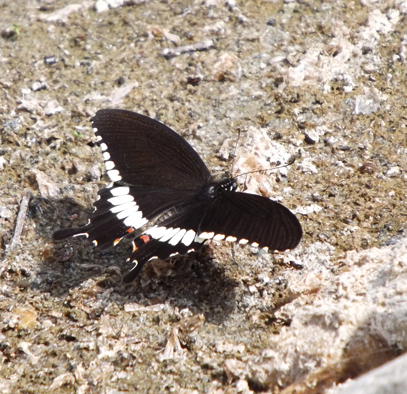 On the third day, I spent a day with Sandy (I had my orders!) so we went for a short walk along the road, photographing birds, butterflies and anything else of interest. It was sunny, hot and humid - great; the humidity wasn’t a problem - you just had to drink lots and lots of water and keep out of the sun in the two hours around midday as it became too hot, so we dodged from shady tree to shady tree along the road.
On the third day, I spent a day with Sandy (I had my orders!) so we went for a short walk along the road, photographing birds, butterflies and anything else of interest. It was sunny, hot and humid - great; the humidity wasn’t a problem - you just had to drink lots and lots of water and keep out of the sun in the two hours around midday as it became too hot, so we dodged from shady tree to shady tree along the road.
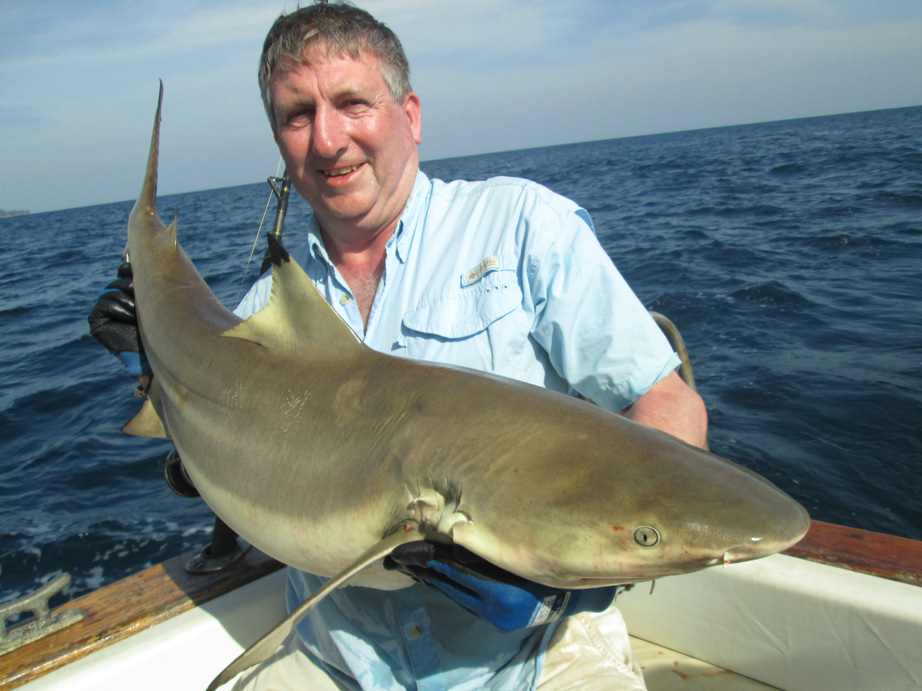 Back at the ranch, we had a lazy afternoon until Reg returned with more tales of trevally and a black tipped shark caught on a plug. Our next major decision was where to eat that evening – it’s a hard life - so as darkness fell, we walked along a darkened road, still busy with tuc-tucs, scooters, cars and bicycles (one of which nearly ran Sandy over but she was saved by a gallant gentleman) in search of a new restaurant we’d seen earlier in the day. Cocktails, (‘Sex on the beach’ & ‘Pina Coladas’) good service, very tasty food and Sandy’s limp-eyed dog which had befriended her on the beach earlier in the week after sharing her breakfast!
Back at the ranch, we had a lazy afternoon until Reg returned with more tales of trevally and a black tipped shark caught on a plug. Our next major decision was where to eat that evening – it’s a hard life - so as darkness fell, we walked along a darkened road, still busy with tuc-tucs, scooters, cars and bicycles (one of which nearly ran Sandy over but she was saved by a gallant gentleman) in search of a new restaurant we’d seen earlier in the day. Cocktails, (‘Sex on the beach’ & ‘Pina Coladas’) good service, very tasty food and Sandy’s limp-eyed dog which had befriended her on the beach earlier in the week after sharing her breakfast!
 The following day was my 56th birthday, so Sandy decided she wasn’t going to chill out any longer. It was time she braved the high seas, so inflicting herself on us, joined us in fishing from the boat and loved every minute of it, much to my relief. It was hard, vigorous fishing and in the heat, sweat dripped into my eyes, so ever-resourceful, Sandy came up the idea of wrapping my forehead with her fabric belt which acted as a sweatband (Reg later bought me a pirate’s hankie!) which kept the stinging sweat out of my eyes. The highlight of my birthday was landing a 66lb giant trevally which was caught on a stick plug. These fish fight to near exhaustion so it is important to play them with all the power you can, to get them into the boat as soon as possible, take a quick photograph then throw the fish headlong into the sea. This shocks them into action, much the same as wild trout. Even then this fish went belly-up briefly but quickly recovered and swam off to cheers from everyone onboard.
The following day was my 56th birthday, so Sandy decided she wasn’t going to chill out any longer. It was time she braved the high seas, so inflicting herself on us, joined us in fishing from the boat and loved every minute of it, much to my relief. It was hard, vigorous fishing and in the heat, sweat dripped into my eyes, so ever-resourceful, Sandy came up the idea of wrapping my forehead with her fabric belt which acted as a sweatband (Reg later bought me a pirate’s hankie!) which kept the stinging sweat out of my eyes. The highlight of my birthday was landing a 66lb giant trevally which was caught on a stick plug. These fish fight to near exhaustion so it is important to play them with all the power you can, to get them into the boat as soon as possible, take a quick photograph then throw the fish headlong into the sea. This shocks them into action, much the same as wild trout. Even then this fish went belly-up briefly but quickly recovered and swam off to cheers from everyone onboard.
The last day was the most difficult. We decided to plug fish until we were tired and resorted to bait fishing with feathers to catch our first fish which in turn became bait. We didn’t take any fish with lures that day although Reg had a few shows and I had a king mackerel take my plug and leap into the air before throwing it.
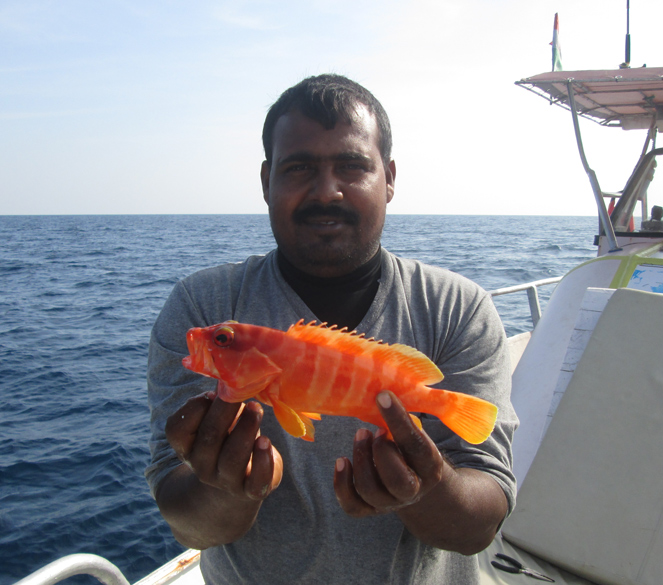 Bait fishing – best laid plans – we couldn’t get a bite on feathers, and when we did they bit straight through the line. It took an age before I caught a small grouper and then two came on the same drop. Armed with fresh bait, Reg showed the way, catching a succession of multicoloured fish looking like they were straight from an aquarium. I opted for larger tackle and struggled to get the hooks to hold, probably having gone to too big a size.
Bait fishing – best laid plans – we couldn’t get a bite on feathers, and when we did they bit straight through the line. It took an age before I caught a small grouper and then two came on the same drop. Armed with fresh bait, Reg showed the way, catching a succession of multicoloured fish looking like they were straight from an aquarium. I opted for larger tackle and struggled to get the hooks to hold, probably having gone to too big a size.
 All too soon, the adventure was over and that afternoon, we watched the sun setting over the islands as we sailed on the ferry back to Port Blair where we were staying at yet another hotel. That evening was great fun; fireworks and more cocktails in the rooftop bar. Next morning, we boarded a flight for Chennai (meeting someone from Bideford at the airport) where we spent our last night. That evening, we explored the shops where Sandy and Reg bought clothes and gifts. The night was hot and humid and though tired from lack and sleep and our extensive travels, we awoke in the early hours to begin our long trek home. What an adventure it had been.
All too soon, the adventure was over and that afternoon, we watched the sun setting over the islands as we sailed on the ferry back to Port Blair where we were staying at yet another hotel. That evening was great fun; fireworks and more cocktails in the rooftop bar. Next morning, we boarded a flight for Chennai (meeting someone from Bideford at the airport) where we spent our last night. That evening, we explored the shops where Sandy and Reg bought clothes and gifts. The night was hot and humid and though tired from lack and sleep and our extensive travels, we awoke in the early hours to begin our long trek home. What an adventure it had been.
We can’t wait to go back. Lee wants to return to the temple in Bhikiyasein in two years’ time and visit a birding resort Gaurav is opening in the North-East, so we will probably do that then. In the meantime, Sandy wants to head back to the Andaman’s again, and also wants to take in some culture at a music festival in Kolkata, where, in February there is also a major bookfair.
I can’t emphasise too strongly how well the trip was put together by A E Travel which is owned by Guarav. Most of our final contact before travelling was with his manager, Sabir Mallick who made sure everything worked out for us. If ever you want to travel in India, we’ll be happy to provide details – our extensive itinerary was virtually faultless and Sandy is already planning the next trip. Fishing in the Andamans was organised by Guarav’s friend Qutub who runs Captain Hook’s in Havelock Island – he was thoroughly professional and ensured that we did everything we wanted to. All being well, we will return within a year for a further adventure in fabulous India and we are literally 'counting the days'.
Keith & Sandy
April, 2013